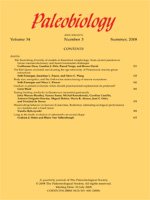In the last decade, several statistical models have been proposed to quantify the relationships among leaf morphological characters and climate parameters. The models, based on modern plants and climate from varying geographic areas, and derived using varied statistical analyses, were intended for paleoclimatic reconstruction based on the morphological characters of fossil leaves. The goal of the research presented here is to evaluate these and newly constructed models in order to estimate past climate in tropical Africa from fossil leaves. Models found to estimate current climate most accurately using modern African leaf assemblages are used to estimate past climate from fossil leaves at three middle and late Miocene paleobotanical sites in the Tugen Hills, Kenya.
Regression models derived from predictor data having a majority of sites from higher than 25°N-S latitude consistently overestimate mean annual precipitation at modern African sites by an average of 990 mm. A pronounced cold season, as at high latitudes, has an inhibitory effect on leaf size, the primary correlate of rainfall, and may negatively affect the accuracy with which models derived from high latitudes estimate rainfall in the Tropics, which lack a cold season. Models derived from data sets consisting of samples from <25°N-S latitude yield similar and more accurate estimates for mean annual precipitation at modern African sites, expressing the predominant relationship between yearly or seasonal rainfall and leaf size at lower latitudes. Models that estimate temperature parameters, whether derived from high or low latitudes, were found to be inaccurate with modern tropical African samples. The hypothesis is proposed that non-entire margins, the primary correlate with temperature, are more likely to be present on the leaves of deciduous plants, whether they lose their leaves because of cold (at high latitudes) or seasonal drought (at low latitudes). Generally, this study indicates that modern predictor data sets from which models are drawn should be representative of the predominant climate parameters expected among fossil sites.
Four regression models are approximately equal in their ability to estimate accurately mean annual precipitation at the modern African sites. They are derived from African data or combinations of African plus other low-latitude data and provide consistent rainfall reconstructions at the three fossil sites. Estimates are 955 ± 29 to 1185 ± 96 mm/yr for Kabarsero (12.6 Ma), 490 ± 46 to 693 ± 32 mm/yr for Waril (9–10 Ma), and 730 ± 30 to 1019 ± 32 mm/yr for Kapturo. Wet-months precipitation estimates are 857 ± 30 mm/yr for Kabarsero, 437 ± 30 for Waril, and 627 ±30 for Kapturo.
These are the first quantitative estimates of climate for the Miocene of East Africa. The seasonally dry climate inferred for Waril may indicate that the Asian monsoon was established by about 9–10 Ma. Alternatively, the seasonally dry climate may reflect local topographic changes caused by rift valley development. However, the plant localities suggest that, although progressive drying may have been a trend during the Tertiary, there was not a unidirectional change from forested to open environments in the Kenya rift between 12.6 and 6.8 Ma, the time interval just prior to the origin of hominids.





